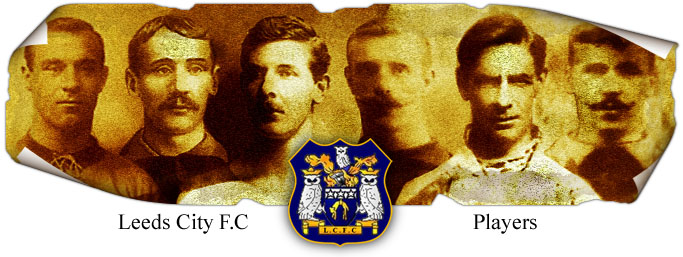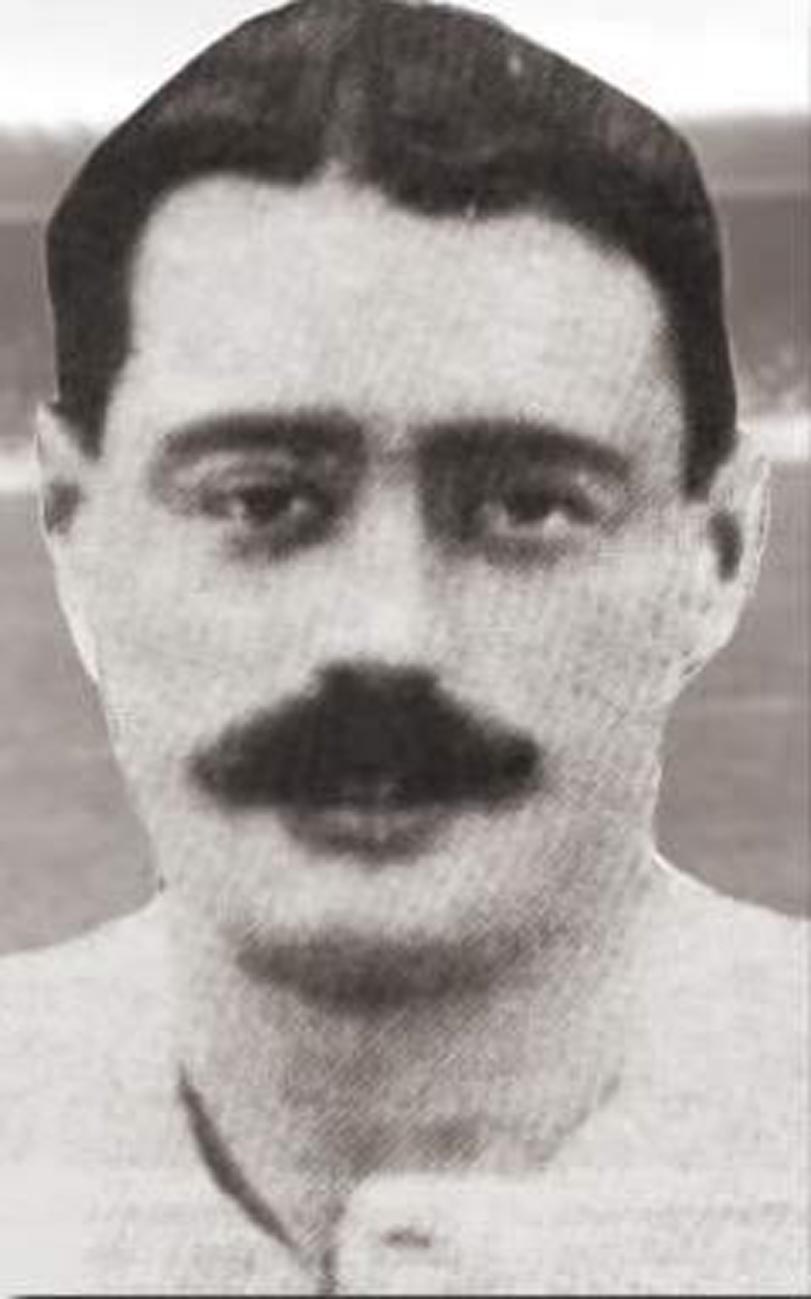

Cubberley: Stanley Morris (Stan)
1906-1913 (Leeds City Player Details)
Wing Half
Born: Edmonton, London: 18-07-1882
Debut: v West Bromwich Albion (a): 08-09-1906
5’8” 11st 3lb (1906)
A carpenter by trade, he began his football career with Cheshunt FC, a useful non-League club, that won the Hertfordshire Charity Cup in 1901, 1904 and 1906 and
reached the Amateur Cup semi-final in 1904. He was from a footballing family, his seven year older brother, Archie, was a forward that played for Tottenham Hotspur in
the Southern League in the 1890's, who played in all of the club's first League, Amateur Cup and FA Cup games, scoring the winner in their first ever FA Cup victory,
against West Hertfordshire in October 1894. His career was cut short by a serious knee injury suffered on Christmas Day 1894. Stan moved on to Crystal Palace,
making one appearance for the Crystal Palace club during 1905-06 and caught the eye of the Leeds City management when they were seeking reinforcements at the
end of that season, their first as a Football League club. He was invited to Elland Road for a trial in Easter 1906, and turned out at centre-half in a friendly against
Cliftonville. He played well, scored a goal and did enough generally to be offered a professional forms. A month later, in May 1906, he signed a full time contract with the
Peacocks and moved to Leeds. Cubberley proved to be an outstanding City player and gave good service for seven seasons. He started as a goal-scoring Inside
Forward but after alternating between those positions and Wing Half he was very adaptable for the City cause and finally settled as a regular in the Left Half spot. After
debuting in a 5-0 drubbing at the Hawthorns, on 8th September 1906. Nimrod wrote in the Leeds Mercury that "Cubberley strove hard, but he lacks polish". He was one
of a few players who were retained for the next game against Lincoln City, and they were rewarded, as he switched to Inside Right and opened his goal account, when
scored City’s only goal in a 1-1 draw. This time Nmrod reported "It was a wonderful effort, with Cubberley throwing himself full length at a Fred Parnell centre as it floated
across the goalmouth "and ball and man went into the net amid a great outburst of applause" He scored half of his goals for City in that first season as he subsequently
settled into the more defensive Wing Half role. Throughout the campaign, he was one of City's most consistent performers and regularly received fulsome praise from
the critics. Cubberley dropped out of the team thereafter, as more experienced players regained fitness, but he became a regular choice at the start of 1907, again at
inside-right. He earned regular plaudits for his hard working displays, though he was never the most cultured of footballers and seemed ill at ease in the role of inside-
forward. He stuck gamely at it, though, and his second goal was the second goal in a 2-0 home win over Wolverhampton Wanderers on 30th March 1907 and the third
came just three games later, when he opened the scoring in a 4-0 drubbing of Gainsborough Trinity at Elland Road on 13th April 1907. This saw him score three goals
in twenty League appearance. City finished the season in tenth spot. He was eventually given an extended run at left-half, and he seemed much more comfortable, and
by late 1907 Cubberley was a regular choice. He made a sterling contribution to City's cause in 1907-08, playing twenty-nine League games. After a draw against
Burnley in November, Linesman wrote in the Mercury, "The display of Cubberley at left-half was one of the features of the game, and the authorities cannot do better than
continue to play him in that position. He got through more work than any other half-back on the field". Flaneur reported for the same paper, "Cubberley is established at
left-half. He nearly always does well, and his play yesterday was neat and effective". By the spring of 1908, financial problems were coming to a head and the club parted
ways with Gilbert Gillies, replacing him with Frank Scott-Walford. Cubberley was one of the few players to retain his place under the new man as he brought in a host of
recruits from the Southern League. Indeed, he was to remain a fixture throughout Scott-Walford's four years at the helm. Cubberley's biting tackles were a regular feature
of City's performances and his presence brought a solid backbone to the midfield. Unfortunately, while attempting to backheel the ball in a home game against Burnley
on 28th November 1908, he twisted knee ligaments and was out of action for a number of weeks. City lost seven straight games during his absence and turned in a
series of insipid displays, making their dependence on Cubberley abundantly clear. He fought his way back to regain a first team berth before the end of the season and
add a further twenty-seven League and four F.A. Cup appearances in the 1908-09. He repaid that show of faith with a series of consistent displays as Scott-Walford
experimented with a host of young Irish imports, which proved an unsuccessful effort to revive City's fortunes. Cubberley was a rallying point for a struggling team making
thirty-five League and one F.A. Cup appearances in the 1909-10 season and was then appointed club captain for 1910-11, when he started thirty-four League and one
F.A. Cup game. He suffered another serious knee injury in November 1911 and missed the majority of the season before returning in the spring after a lengthy
recuperation. When he regained his place it was far too late to make a real contribution. He made twenty League appearances as City finished in the bottom two at the
end of a dismal season and had to apply for re-election with Scott-Walford resigning his position. As Wanderer observed in the Mercury, "All who know Cubberley's
abilities will recognise what a big handicap this was to the team". Perhaps due to lack of mobility caused by his injury, Cubberley put on quite a bit of weight during the
summer months and was not the same player in 1912-13 as he had been in earlier years, though he was still an automatic choice at the start of the campaign. Incoming
manager Herbert Chapman was disappointed with the lack of impact made by new inside-left Andy Gibson, and turned to Cubberley for cover in the position. Chapman
thought he would do a decent job in the role and was happy to deploy Mick Foley in Cubberley's customary left-half position. Though never lacking commitment,
Cubberley struggled to make a telling contribution in the forward line. He did manage to score three goals, the first of which was enough to secure a 1-0 victory at
Bradford Park Avenue 21st September 1912. According to Old Bradfordian in the Leeds Mercury, it was "a beauty headed through by Cubberley after pretty combination
on the part of Lintott, McLeod and Roberts." His second successful strike for the season came in the 4-1 defeat of promotion-chasing Burnley, at Elland Road on 26th
October 1912. On the whole, though, Cubberley struggled. The Yorkshire Post: "Cubberley was not exactly a failure at inside-left, but he lacked speed and incisiveness.
Cubberley has been too long a half-back to be now converted into a successful forward". In sharp contrast, when he did occupy a deeper role, he was often rated the
"best of the half-back line". His third goal came on Christmas Day 1912 in the 1-2 home defeat by Grimsby Town. Committed to a programme of team rebuilding,
Chapman recruited a number of new forwards around the turn of the year, including celebrated Bradford City inside-left Jimmy Speirs. Considering Cubberley's best
days behind him, Chapman declared him surplus to requirements and sanctioned a move to Swansea Town in January 1913. In his final season with City he doubled his
goal-scoring contributions as he was once more pushed forward in the more advanced positions. He played his final game in his sixteenth League appearance of the
season on 18th January 1913 in a 2-0 home win over Bradford Park Avenue. It brought his Leeds record to six goals in one hundred and eighty-one League
appearances and a further seven games in the F.A. Cup. At the end of the 1912-13 season Cubberley joined Non-League Swansea Town. He remained there one
season before he, and team-mate Arthur Allman, left to join First Division Manchester United, but he never made the Old Trafford first team in peacetime, where he
ended his playing career, appearing twice in 1915-16. During WW1 he enlisted with the M.T. section of the R.A.S.C. and in August 1919 was based at Grove Park.
Stan Cubberley was a Leeds City player for over seven years. He was a mainstay of the Elland Road club during its short existence, with only Billy McLeod, Fred Croot
and George Affleck playing more games. He could never be described as a brilliant individualist or a flamboyant performer, but Cubberley was a selfless team man,
who never surrendered possession without a fierce struggle. He was a determined opponent, committed and dedicated, and could always be relied upon to give of his
best in the Leeds cause. Playing at half-back for City was a thankless task and Cubberley and the various colleagues who partnered him there were often the butt of
newspaper criticism. His perseverance and commitment in the face of such snide antipathy was admirable. Had Leeds contained more men like Cubberley in their
ranks, it is conceivable that they would have been able to escape from their Second Division straitjacket. As it was, he had to be satisfied with the status of being one
of City's great stalwarts. Cubberley earned a living as a motor mechanic and died in Patricroft, Barton upon Irwell, Lancashire, on 15 June 1933.
| Appearances | Goals |
| League 181 | 6 |
| F.A. Cup 7 | 0 |